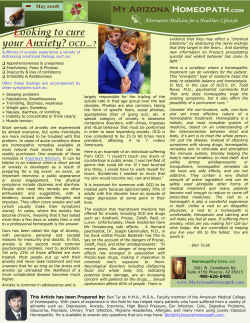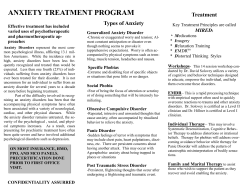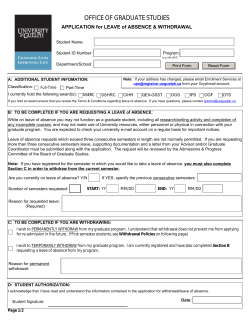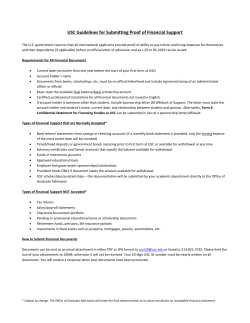
The Benzo Trap
The Benzo Trap Anti-anxiety drugs ensnare millions of Americans in a web of addiction and pain. By Matt Samet Teryn Taylor, of Marion, Indiana, has “benzo” voice: flat, devoid of emotion, almost robotic—the result of her unwitting dependence on anti-anxiety drugs (aka benzodiazepine tranquilizers). Taylor hardly looks the part. A former long-distance runner, straight-A student, and the mother of a 7-year-old daughter, this pretty Midwestern woman reached out for help after her mom died in 1996. Although no one ever diagnosed Taylor as clinically depressed, she received that help in the form of a prescription for Paxil. After two years, Taylor decided she wanted off the antidepressant, so she quit cold turkey under her doctor’s orders. Bad idea. Almost immediately she experienced high levels of anxiety, a racing heartbeat, and a loss of equilibrium. She was, as she remembers, “a drooling, shaking, heart-palpitating, muscle-constricted mess.” So her doctor prescribed Klonopin, a potent, anti-anxiety benzo. Unfortunately, as her body grew accustomed to that drug, she needed more of it just to keep her anxiety at bay. Any attempt to quit, she says, sent her into a painful and protracted withdrawal—making her even more anxious. Taylor stayed on benzos for seven years, and her withdrawals came with horrific side effects. “I spent most of my days on the couch,” she says, so weak she could barely function. Plagued by electric jolts called “brain zaps,” difficulty breathing, and a pervasive sense of terror, Taylor likened her experience “to being a prisoner of war.” While not to undermine the severity of Taylor’s withdrawal symptoms, perhaps the true horror of her story lies in its broad-picture similarity to those of thousands of other benzo “slaves.” An estimated 5 million people in the US take regular “therapeutic doses” of these drugs, and worldwide, at least 3 percent to 15 percent of adults fill benzo prescriptions, according to leading benzo expert Heather Ashton, MD, of the University of Newcastle upon Tyne, in England. Potentially, all of these people face some sort of withdrawal ordeal. The too-easy solution So how did these drugs become so pervasive? At first, they seem to offer a cure-all for any type of anxiety. But masking feelings isn’t always the smart thing to do. Fear and anxiety, for example, actually perform a valuable function: They keep us out of harm’s way. In the face of a real or perceived threat, fear triggers the “fight-or-flight” adrenal response—a normal physiological mechanism designed to keep us alive and safe. Sometimes, however, imagined threats trigger the fear response over and over again, leading to anxiety disorders. The Diagnostic and Statistical Manual of Mental Disorders IV lists 12 types of anxiety under such categories as phobias, generalized anxiety, panic disorders, and obsessive-compulsive disorder. All of these conditions can cause extreme psychic and physical discomfort. Those in the midst of a panic attack, perhaps the most acute manifestation of anxiety, experience a slamming heart, intense sweats, and hyperventilation—even the fear of imminent death as the sympathetic (arousing) nervous system overwhelms the parasympathetic (calming) response and floods the body with adrenaline and related noradrenaline hormones. For this type of acute psychological distress, short-term use of benzos—no more than two weeks—can sometimes help, says Ashton. The problem? Many psychiatrists and general practitioners prescribe benzos (most commonly Ativan, Klonopin, and Xanax) as a first-line treatment for everything from muscle pain and insomnia to grief and anxiety—in other words, for the vicissitudes of life. An in-depth report by Health Canada (the country’s department of health) titled “The Effects of Tranquilization: Benzodiazepine Use in Canada” summarized the situation best: “A major factor responsible for the acceptance of these drugs has been the pervasive mythology that there are instant solutions to problems of living and that the most effective and rapid solutions are chemical in nature. Society has come to expect quick responses to any problem, whether it be the common cold, anxiety, or grief.” By accepting this philosophy, continues the report, “many people have come to view benzodiazepines as essentially a social and recreational drug, not unlike alcohol.” And yet, an established and growing body of research links long-term use of these drugs with such serious neurological and psychological risks as brain atrophy, emotional anesthesia (a numbing of the emotions), memory impairment, and suicidal tendencies. Let me give you something Alas, the overprescribing of psychiatric drugs is nothing new. In 1960, Librium, the first benzo, hit the market with the slogan: “Whatever the diagnosis—Librium.” This pushed the idea that common, physiological complaints—asthmas, ulcers, hypertension—were mere manifestations of anxiety. Soon the proto-benzo Valium, later satirized by the Rolling Stones as “mother’s little helper,” burst on the scene as a safe, nonaddictive solution to stress and an antidote to a woman’s inability to cope. By the 1970s, Valium became the most heavily prescribed drug in America, according to psychiatrist Peter Breggin in his seminal book Toxic Psychiatry (St. Martin’s Griffin, 1994). In fact, in the drug’s 1978 heyday, Americans popped more than 2 billion tabs of Valium. Xanax, stronger yet, replaced Valium in 1986, even though the problems with long-term benzo use (including addiction) had, by that point, been well-documented. Commonly prescribed benzos today include the aforementioned Ativan, Klonopin, and Xanax, as well as the sleeping pill Restoril. The “non-narcotic” sleeping medicines Ambien, Lunesta, and Sonata, while not technically benzos, act similarly on the brain and can cause the same problems. Benzos have been overprescribed “partly because they were safer than barbiturates [earlier-generation tranquilizers],” says Ashton, “and partly because of very strong drug company pressure, ignorance, and the gullibility of doctors trying to be kind to their patients.” Doctors, says Ashton, tend to ignore the literature, which warned about the problem at least since the Valium overprescription debacle of the 1970s and 1980s, and they routinely ignore prescribing guidelines (including those of the FDA) that cap daily usage at two weeks. How they work Benzos don’t get you high or give you a rush. They relax and calm you. They do this by enhancing the action of a neurotransmitter called gamma-aminobutyric acid (GABA), a “built-in calmer or an internal benzo if you like,” says Ashton. Your brain cells have receptor sites for GABA, and benzos increase those receptors’ affinity for the calming neurotransmitter. But when all your GABA is “enhanced” by benzos, “the brain thinks, I don’t need all this GABA around, so the receptors for it go away—they internalize, or invert, into the inside of the nerve,” says Ashton. As you lose GABA receptors, you begin to feel anxious again, even though you’re still on the benzo drug. Clinicians call this “tolerance withdrawal.” Now, says Ashton, you have to increase the benzo dosage to get the same calming effect—a vicious cycle that seems to explain the millions of Americans taking regular doses of these drugs. Other problems also beset those who take benzos daily. The Health Canada report found that long-term use impairs learning ability, motor skills, and sex drive as well as the ability to empathize with others and to cope with stressful situations. “We regularly see individuals with such issues as confusion, generalized fatigue, sleep disorders, slurred speech, and even motor problems like uncoordination and unsteady gait,” says David Perlmutter, MD, a neurologist at the Perlmutter Health Center in Naples, Florida, and author of The Better Brain Book (Riverhead, 2004). The withdrawal syndrome The situation worsens when people want to stop taking anti-anxiety meds. Most doctors give their patients the impression that the drugs are nonaddictive and perfectly safe, says Ashton, misinformation that trickles down from the pharmaceutical companies. In reality, during benzo withdrawal, “you go into hyperdrive and acute anxiety,” she says, because your body has become dependent on the tranquilizers. You might also face profound insomnia, panic attacks, muscle tremors, muscle stiffness, sweating, palpitations, gastrointestinal distress, hallucinations, and nightmares. The hospitals, detox centers, and doctors who follow a typical addiction-treatment protocol frequently insist that patients, like Taylor, wean themselves from benzos, even at high doses, in a matter of weeks or even days. But when stopped abruptly—and in an unlucky few, even when tapered slowly—benzos can foster a withdrawal syndrome much more severe than almost any other drug. Such rapid cessation can lead to complications like protracted (18-plus-month) withdrawal periods, and even psychosis, seizures, and death. “In this respect, getting people off benzos may be just as challenging as cocaine and other ‘street drugs,’” says Perlmutter. And to make matters worse, he continues, these drugs enjoy legal sanction, so there’s often “less compassion offered to individuals addicted to benzos, compared to those addicted to more glamorous drugs.” Escape the trap The best way to avoid the dangers of anti-anxiety drugs, of course, is not to take them in the first place—or to take them only in acute, emergency situations and even then for no longer than two weeks. In times of stress, anxiety, or panic, look to exercise, diet, mind-body practices, and other techniques to bolster your body’s ability to calm itself. If you’re already dependent on benzos, keep in mind you must wean yourself from them slowly. “The inverted GABA receptors—big protein molecular structures that take a lot of brain and body energy to resynthesize—have to come back again,” says Ashton. “This takes time and a lot of metabolic energy, but it does happen.” Depending on your starting dose and how you taper, the GABA receptors can sometimes take years to fully regrow, so that the neurotransmitter can do its job and relax you. Anyone looking for guidance in slowly tapering off anti-anxiety drugs should turn to the Ashton manual (Benzodiazepines: How They Work and How to Withdraw; www.benzo.org.uk/manual.) The so-called “Ashton Method” draws from Ashton’s research and years of experience running an outpatient benzo withdrawal clinic, during which time she saw hundreds of people safely wean themselves from the meds. First off, Ashton encourages patients to switch to Valium, which has the longest half-life of any benzo. (The half-life is the time it takes for half a given dose to leave your body, which is 200 hours for Valium.) Because Valium clears a little bit at a time, the drug is almost self-tapering, with a gradual comedown that creates less anxiety than fasteracting benzos like Xanax and Klonopin. The more slowly you taper, the greater chance your GABA receptors have to regenerate with each dose reduction. You can further ease the withdrawal by adding anxiety-reducing techniques such as yoga, breathing exercises, and streamlined nutrition (see “Survival Tips” below). Alison Kellagher, who has a master’s degree in counseling, works with those who want to quit or who are currently in withdrawal mode. A benzo survivor herself, Kellagher underwent five abrupt withdrawals, the final one off 7 mg a day of Klonopin in 2002. Kellagher took three years to heal before returning to the Nordic skiing and competitive cycling she’d been forced to set aside while benzo sick. Because she knows just how bad withdrawal can be, Kellagher coaches her patients in acceptance, using simple breathing and relaxation techniques and calming (nonstrenuous) yoga poses to combat the fear state of withdrawal. “The central thing is to help people recognize the syndrome,” she says. “They need to understand that this is an existing and understood withdrawal syndrome, and recognize where they are in the process.” Kellagher also counsels patience; simple living (eating well, avoiding stress, and sleeping when you can); and caution when adding outside agents (vitamins or supplements) to try to mend the nervous system. Concentrated amounts of individual nutrients may further upset the delicate neurochemical balance in benzo patients, she says, so it’s better to get your nutrients from foods. Calm waters ahead Despite these formidable challenges, people do escape the benzo trap. For those who taper slowly, Ashton pegs relapse rates at only 10 percent. After the withdrawal period, people rarely get cravings. The body heals itself, and life goes on. Many even say their lives are much better than before. Now tapering her final psychiatric medicine at a slow, cautious rate, Teryn Taylor moves closer to her goal of wellness with each cut in dosage. She says she’ll consider herself completely healed when her symptoms subside 100 percent, and that she’ll be the “happiest person on the planet to have made it through this.” Taylor won’t return to her old job as a speech therapist—instead she wants to focus on helping other people addicted to benzos. “It’s still hard for me to believe that this is my story,” she says. “It’s just so barbaric.” Matt Samet, a Boulder, Colorado-based freelance writer, just celebrated two-and-a-half years’ freedom from benzodiazepines after 13 years on them. Survival Tips When tapering off benzos, the following tips will help see you through the withdrawal: Pace yourself. Do not push too hard—physically, socially, or emotionally—even when you feel good. Overextending can lead to heightened withdrawal and demoralizing setbacks, says benzo survivor Alison Kellagher. Your system, she says, wants you to “sit down and heal.” Avoid caffeine and sugar. Patients in benzo withdrawal, says neurologist David Perlmutter, MD, can become hypersensitive to the stimulating effects of sugars. Instead, he recommends whole, organic foods and an intake of “adequate dietary protein” several times daily, as well as complex carbohydrates (like whole grains), to smooth out blood-sugar levels. Learn acceptance, patience, and wisdom. Many have chased dead ends with doctor’s visits and needless therapy, only to recover fully from their anxiety issues once the withdrawal ended. In withdrawal, “we have to learn to use our minds to calm ourselves—not just our bodies,” says Kellagher. “Looking to the wisdom traditions— yoga, meditation, prayer—is probably the best place to go.” Walk. According to Perlmutter, exercise—even mild exercise—releases the braincalming chemical serotonin. So while jumping on a treadmill or stationary bike may seem overwhelming, a short walk is doable even on the worst days. You should walk with “conscious awareness that it’s not just to get from one place to another, but is a meaningful activity serving an integral role in your recovery,” advises Perlmutter. Distract yourself. Any pleasant diversion, such as a crossword puzzle, phone conversation, or nonviolent movie, will fill time and declaw certain withdrawal symptoms. “I took a job in a bakery five months after stopping benzos,” says Kellagher. “The structured time was really, really helpful.” Breathe. Diaphragmatic breathing—drawing breath in through the nose and out through the mouth, with a two-second pause after exhalation—calms the nervous system. Yoga. Very light yoga, in a therapeutic yoga class, with a partner, or using a DVD, will help you feel at peace. Kellagher does yoga with her clients, running through a routine based on grounding movements and those that bring a sense of safety and security. “It helps people to do the yoga with someone else, too, to feel connected,” she says. The Needle Solution According to Boulder, Colorado-based oriental medicine practitioner David Scrimgeour, LAc, acupuncture works as an integral part of a withdrawal plan by: • Stimulating the release of feel-good neurotransmitters such as endorphins, inducing an overall calming and balancing effect on the body’s central nervous system. • Decreasing anxiety during the withdrawal phase by prompting the release of chemicals in the body that occupy the receptor sites once targeted by the benzo. It also lowers ACTH (adrenocorticotropic hormone) levels—like excess adrenalin or elevated cortisol—further balancing the nervous system. • Activating ear points, which (as scientists discovered in the 1970s) have a very strong sedating and regulating effect on both the sympathetic and autonomic nervous systems.
© Copyright 2025


![벤조[α]피렌 (Benzo[a]pyrene)](http://cdn1.abcdocz.com/store/data/000712087_1-9d06dab7ab4bc17fe4dca91f6f1d9a77-250x500.png)







